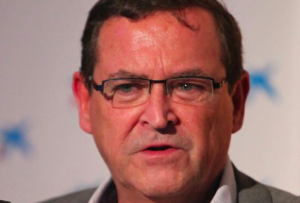
Meet our President: Getting to know Charlotte Rydh
January 12, 2022
Rebecca Allaigre: For transformational change, move from budget-based to mission-based fundraising
February 9, 2022After almost two years of fundraising amid a global pandemic, nonprofits are all too accustomed to working through periods of change. While 2022 sees Covid cases reach record levels, a new year offers new hope. We ask 8 fundraising experts what they think 2022 will bring for fundraising, rounding up their views here.
With Covid cases continuing to rise at lightning speed in Europe, if there’s one thing we can be certain of from 2022, it’s that this pandemic is far from behind us. The year is unlikely to be a smooth ride for fundraising, with limitations on events and reduced face-to-face interaction looking set to continue, and economic pressures only increasing the need for charitable services.
But it’s not all doom and gloom. Fundraisers are all too used to working in a climate of perpetual change – developing new skills and, as our recent Nonprofit Pulse report shows, focusing on strengthening and deepening their supporter relationships.
With two years’ experience of the pandemic under their belt, agility has become second nature for many, bolstering resilience and massively accelerating innovation and digital transformation across the sector. We’ve seen some incredible examples of digital fundraising and storytelling, ranging from live broadcasting on social channels to gaming events, brand-jacking, and nonprofits making great use of TikTok.
As time moves on, the pendulum is shifting towards a more hybrid world, with the sector working hard to build on their digital offering, while reintroducing and reshaping fundraising activities and services in the physical world.
Predictions for the year ahead
With this in mind, we ask eight fundraising experts to share their predictions for 2022. Spanning a range of topics, digital channels are of course front of mind within the group, with exciting opportunities for further innovation and supporter engagement cited. Still, the question remains over how to build and strengthen the most committed supporter relationships in this hybrid space.
Recognising that different people, different demographics want different things from the organisations they engage with, those relationships and supporter insight will surely be even more important as nonprofits seek to draw supporters closer to the organisation and inspire them to become part of their community and movement for change. Similarly, relationships with government and other funding bodies will be key.
Legacies are predicted to flourish in the coming years with the Baby Boomer generation, but acquisition of individual and committed givers through more traditional channels is becoming increasingly costly, particularly in the current climate. The challenge is whether – in a crowded digital space – social marketing tools, online and email will be sufficient to plug that gap and recruit new regular givers to the cause.
Nonprofits are becoming bolder in their communications, using social channels more widely to share behind the scenes stories of their work. But in today’s ‘cancel culture’, where loyalty and trust are hard won and easily lost, managing risk and reputation is a critical factor.
When it comes to the profession itself, there’s greater understanding that fundraising really isn’t easy and of the need for skilled professionals to do the job. This makes it all the more important that fundraisers are paid properly for their work and inspired to progress. And yet, with nonprofits facing increasing financial pressures, will the sector be able to stem the tide of good people leaving the profession?
Building on the digital advances and agility shown in recent times, 2022 brings an opportunity for further innovation and growth. But if the sector is to achieve its potential with fundraising and in creating the most engaging and nurturing supporter experiences, renewed focus on the workforce will surely be vital.
Charlotte Rydh: Drawing supporters in to join our movement, not just fund it

Charlotte Rydh, Give Sweden / EFA
It’s always hard to think about fundraising trends at a European level as there are so many cultures and nations at play, but there are several common threads. Of course, there’s been huge re-adjustment in the way nonprofits work after the chaos of Covid. The pandemic isn’t behind us, but we’ve become more accustomed to working through change, to being agile and constantly reviewing how we do things, and to combining digital with traditional fundraising activities. We’re all still finding our way with this new hybrid environment, but what I see is a welcome shift in drawing supporters closer to the cause and encouraging them to get more involved. Increasingly, nonprofits aren’t simply asking supporters for help, but inviting them to join their movement – and I think that’s really exciting. The challenge for us now is how best the sector can channel that, what can we offer supporters and how does this sit with the equally important need for funds.
Charlotte is general secretary of Giva Sverige (Give Sweden) and president of EFA.
John Baguley: Building trust, respect and returns from digital

John Baguley, International Fundraising Consultancy
Trust has always been key. As Covid keeps major donors away from charities and projects, we’ll see those touchpoints that confirm the bona fides (trustworthiness) of charities replaced by the personal relationship between the wealthy and major donor fundraisers. But the danger is that we’re losing a constant stream of excellent fundraisers. We need to pay them better, give them more respect and improve their career path – above all listen to those exit interviews!
When it comes to digital, research into returns from social media marketing will be crucial. The percentage returns will lessen and the blunt messaging instruments will need constant refining. New opportunities are emerging all the time. Profitable and fun, I’d expect to see non-fungible tokens (NFTs) starting to take their place in the fundraising mix with charities accepting cryptocurrencies to pay for the donated art. Who will be the first out of the block on this?
John is executive chair of the International Fundraising Consultancy
Michelle Chambers: Greater focus on the desires and needs of different demographics

Michelle Chambers, THINK Consulting Solutions
This year it will be increasingly important to develop an understanding of how different demographics want to engage with and support your cause. For the first time, we are seeing a move to a wider demographic spread amongst supporter bases, with all age groups giving voice, money and time, and a particular set of trends for giving amongst Millennials and Gen Z. Understanding what these different audiences want, using research rather than supposition, is key and 2022 will see more and more charities expanding their knowledge base in this way. There is much freely available research and insight for broad demographic trends, which should be supplemented with bespoke intelligence gathering. This needs to be underpinned by robust systems for storing, retrieving and analysing data to drive insight and inform business decisions.
Michelle is managing director of THINK Consulting Solutions
Elly Lont: A step closer to normalising legacy giving

Elly Lont, Greenpeace-NL / legacygiving.eu
In the last years, many organisations saw an increase in legacy income, not caused by Covid-19 only. For the following years, an increase of visible legacy fundraising campaigns will shift the public awareness about legacy giving more. Combined with altering social conventions, a shift from the Silent Generation to the more unconventional and idealistic Baby Boomers, where more and more people do not only want to leave to their loved ones but also to their ideals, make the coming years promising and exciting.
We are not there yet, but 2022 will bring us steps further in making ‘leaving a gift in your will’ a social norm. More and more organisations worldwide see and seize the beautiful opportunities of legacy fundraising. This will provide charities significant financial resources to make this world a better place – the reason why we, as fundraisers, do what we do.
Elly is senior fundraiser at Greenpeace-NL and co-founder of legacygiving.eu
Nana Crawford: More of a focus on risk management, and honest communications

Nana Crawford, British Red Cross
I believe organisations should be focusing on risk and reputational management especially for their social teams. With ‘cancel culture’ alive and kicking, sometimes apologies won’t cut it anymore. Nothing is ever really gone from social, and we know it can spread very fast, so if organisations are preparing to be bolder with their comms, they need to make sure they have the right steps in place to handle any risks.
I don’t want this to put people off from speaking out or trying something new but rather be prepared to be more honest, transparent if it doesn’t quite work. If you make a mistake, don’t just apologise, show us how you’ll learn from it.
Nana is social media manager at the British Red Cross
Ricard Valls Riera: Fundraising costs will continue to spiral
 In 2022, hybrid fundraising will be the norm, there will be continued growth in online giving, with traditional channels playing a key role too. But the concern here in Spain is that fundraising costs from the main acquisition channels (face-to-face and telemarketing) will keep on rising. There’s now a lack of good face-to-face providers, and although we’re seeing salary growth, it’s difficult to find good ‘facers’ – likely a symptom of the ‘great resignation’, following the pandemic.
In 2022, hybrid fundraising will be the norm, there will be continued growth in online giving, with traditional channels playing a key role too. But the concern here in Spain is that fundraising costs from the main acquisition channels (face-to-face and telemarketing) will keep on rising. There’s now a lack of good face-to-face providers, and although we’re seeing salary growth, it’s difficult to find good ‘facers’ – likely a symptom of the ‘great resignation’, following the pandemic.
The contact level for telemarketing is dropping, even when it comes to mobile numbers, and the cost per donor is increasing, particularly on lead conversion. So this begs the question: what is the acceptable cost for donor acquisition? And what happens when that cost climbs too high? As online giving takes on a bigger role, digital marketing tools will be critical and organisations will need to try new strategies to attract regular donors online.
Ricard is CEO of Zohar Consultoria Marketing & Social (Spain)
Nolwenn Poupon: French presidential elections add to the shadow of uncertainty

Nolwenn Poupon, France générosités
2022 will be another challenging year for fundraising all over the world because of Covid-19, but in France, the presidential elections make it even more uncertain. Here, studies show that presidential election years are not the best for fundraising or generosity. The climate of elections and the risks of changes, especially on taxes, may disrupt individual donor actions. Thankfully, around half of individual giving comes from Direct Debit, sustaining an important part of the annual income stream. After Emmanuel Macron’s elections, individual donations dropped by 4.8% from 2017 to 2018 in France due to tax changes put in place by the new government. It was the only fall in 15 years of fundraising. This is why France générosités will meet all the 2022 candidates to explain the impact of charities’ actions, the importance of private resources and propose several measures to develop generosity and fundraising in France.
Nolwenn is head of studies and communication at France générosités
Robert Kawalko: Growth of the fundraising profession

Robert Kawalko, Polish Fundraising Association
Since the pandemic, we’ve seen a positive shift in Poland, with fundraising being taken more seriously as a profession and I think we’ll see continued growth in that respect. More charities are recruiting and asking for our help with that and what is even more interesting is that each time there are valuable candidates ready to take up the challenge of becoming fundraisers, although they know that it will not be easy. Increasingly, these people are new to the profession. They like the idea of working in line with their values and with people who live by ideals. Fundraising is gaining more recognition and it’s starting to seem feasible that the presence of fundraisers will become a norm in organisational teams.
Robert is president of the Polish Fundraising Association
Main photo by Rob Wicks on Unsplash




